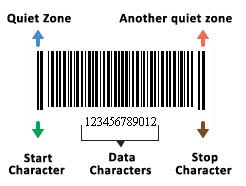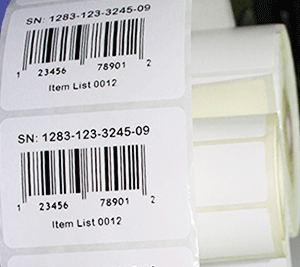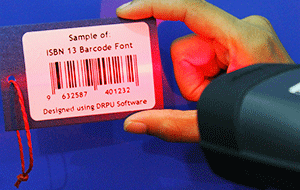What is Barcode?
Barcode is the small image of lines (or bars) and spaces that is used in retail store items, identification cards, postal mail and other commercial sectors to identify a particular product. When you purchase any item from store, you will notice a label with thin, black lines across it, along with variation of different numbers. When this label is scanned by any scanner, then the item information like item description, price comes up. This label of thin black line is called barcode. Barcode is used to read information based upon the widths of those small black lines. Barcodes are becoming more and more common in consumer life. You can see the barcodes in supermarkets, on labels, greeting cards, consumable goods, inventory products etc.
So in the simple way, barcode is a machine readable form of data on scan able, visual surface. The information within barcode is read by a barcode reader then it is transmitted into database where it can be logged and tracked. Barcodes can help you to maintain accurate information about inventory product, their price and other important business related data.
Every barcode begin with a special start character and ends with a special stop character. These codes help to detect the barcode. Some barcodes includes checksum character before the stop character. A checksum is calculated when the barcode is printed using the characters in barcodes. Barcodes can be used to capture sales data for forecasting, automate the price of any product and remove the need to apply pricing labels on product, helps to improve supply chain efficiency on outer cases and pallets etc.

The History of the Barcode
The idea to create barcode was first explored in 1932. The first barcode designed to be patented was the bulls eye barcode (in 1949), which was created as a set of concentric circles that could be scanned in any direction.
In the 1960’s before barcoding system made an impact on society, which was when it was developed to track railroad cars across the USA. However, even this was considered too expensive.
Barcode was first commercially used in 1966 and in 1970 and industry standard was set in Logicon, Inc. In 1970 the first company to produce barcode equipment for retail trade uses UGPIC (Universal Grocery Products Identification Code). In the June of 1974, the first U.P.C. scanner was installed at Marsh's supermarket in Troy, Ohio. On 26 June, 1974 the first product scanned at the checkout with barcode was Wrigley's gum.
Today, the barcodes are used in many areas like post office, banking sectors, retail business, warehousing industry, shipping supplier, distribution industry, boarding passes, luggage routing for air travel, tickets for entertainment events, store registries, patient identification in hospitals, floor control in warehouses etc. GS1 US estimates in every day, five billion scans take place over worldwide.
Why you should use the Barcode?
Barcode system helps you to improve operational efficiency, reduce overhead, provide better customer services and increase the visibility of your business organization. Using the barcodes you are able to:
- Eliminate the possibility of data entry errors.
- Improve the inventory control process.
- At any time may dash
- Save your valuable time to manage the inventory products or goods.
The information encoded in barcodes depends upon which type of barcode symbology is used. Different barcode symbologies are used to encode different types of data. Some barcode symbologies, encode only numeric data while the other barcode symbologies encode letters, punctuations and numbers.
How does Barcode work?
There are a lot of types of barcodes, but the most common one used barcode is UPC barcode, the Universal Product Code. In UPC barcode each digit is coded by two black and two white stripes. The widths of stripes are from 1 to 4 units and the total width for each digit is always seven units.
Barcode scanner (or barcode reader) is used to Read the bars and spaces in the barcode. As the barcode reader picks up the bars, then it transfers the information to computer where the record related to that barcode is stored. The computer records may include information like price, number of items available and other pertinent information about that barcode. So once any barcode reader read barcode the whole information about that barcode will be display on your computer screen.
Barcode is self-contained, encrypted message with information encoded within the bars and spaces (of barcode) in specific manner. Every barcode symbology contains set of specifications that assigns the specific widths of the bars, spaces and their allowable tolerances. Bars and spaces within barcodes are called as elements. Depending upon the types of barcode symbology used, individual barcode symbology can use five, seven, eight and nine elements to code a single character.
Typical barcode contains the five parts which are quiet zone, start character, data characters (including an optical check character), stop character and another quiet zone.
Barcode consist of black bars and white spaces of varying widths. Barcode is used to uniquely identify any product or items. Barcode labels are read with barcode reader. There are so many ways to arrange these black bars and white spaces. Some of the common barcode symbologies are QR code, UPC/EAN, Interleaved 2 of 5 (I of 5), Codabar, Code 39, Aztec, databar, maxi code, micr font etc.
Barcode technology determines the mapping and interpretation of the encoded information within barcode. This encoding allows the barcode scanning device to know when a digit or characters are starts or stops. Barcode technology provides simple and inexpensive method of recording data in number of applications. The symbologies that are used within barcodes technology can be arranged in mainly two ways i.e. continuous and discreet barcode symbology. In the continuous barcode symbology, the encoded characters begins with black line and end with white lines or spaces. While in the discreet barcode symbology, the encoded characters are in black lines, spaces and another black line.
Some of the barcode technology uses two separate widths line to determine the character while others uses multiple width lines. The use of encoding styles is depends upon the application for which the barcodes technology is used.
- Rule to represent data in an optically readable format.
- Technique to read and decode the barcodes data.
- Rules to measure the quality of printed barcodes.
Barcode is series of narrow and wide bars which can be scan through photo type sensor. The sensor reads the barcodes data and converts it into signal which is then sent to computer. A barcode font is an organized collection of text characters. Barcodes font define shape, size and spacing of text characters. Barcode Font is specially designed to generate barcodes on normal text characters.
There are mainly two types of barcode font i.e. Linear barcode font and 2D barcode fonts.
Linear barcode encodes data in one dimension only. In the linear barcode the information encoded in the widths of the bars and spaces and no data is encoded in the lengths of the bars. Linear barcodes are made up of lines and spaces of various widths. UPC and EAN barcode symbol is the types of linear barcode that is used on many retail products.
2d barcode also known as matrix code. 2D barcodes contains more data than the linear barcodes. Two dimensional barcode stores data both horizontally as well as vertically. 2D barcodes can store data up to 7,089 characters.

Barcode Labels:
A barcode label is used to attach barcode to any products. The size of barcode label is depends upon the information that you want to put on it. The barcode labels used in different applications like asset identification, to track, maintenance and control calibration activities. They are also used in supply chain management and warehouse industries to track inventory product.
Barcode label is basically barcodes tag that help you to identify any particular product. There are mainly two types of two techniques that are used to encode data on barcodes. The first technique uses number of black lines to encode encoding data on barcodes label. These lines vary in thickness and spaces between them. The second technique which is used to encode data on barcode labels is through the use of 2-dimensional patterning of dots. These dots differ from each other in thickness and placed on rectangular or squared frame.
Since the information on barcodes coupon could not be read by human, so that barcode scanner is used to read the barcodes data. A barcode scanner can easily scan information of barcode labels and decode them.
Barcode Sheets:
A barcode sheet is the page that is used to print the barcodes. In many situations, you want to store more data to barcodes. If you want to deploy a new asset for any user, then you should use the barcodes to quickly enter data. Data that are to enter includes the assigned location, department and cost center along with their identity. To increase data entry process and reduce errors, barcode sheet is used.
Barcode sheet is used to frequently enter data on barcodes. To read barcode sheet data the barcode sheet is scanned through the barcodes reader after that all the data of barcode sheet is decoded.
Barcode label generator software free demo download to create professional quality barcode images and assets tags according to user specified fonts, color, size and shape. Program provides options to generate special types of barcodes by entering data and selecting the barcode fonts.
Barcode labeling and printing utility provides options to design barcode images using various types of designing object like line, pencil, rectangle, picture, text and ellipse. Software supports all commonly used barcode scanner and printer or provide options to generate barcode in different file format.
Barcode label generator is a most advance and powerful barcode labeling and printing utility to generate professional quality barcode images in 2D and linear fonts. Fully professional barcode label maker utility provides options to change barcode size, shape and color according to user needs and requirements.
Barcode label maker software is capable to create and save barcode labels in required file format such as ICON, TIFF, JPG, JPEG, BMP and GIF. Professional barcode label maker is a complete solution for all your barcode labeling and printing needs.
Fully professional and easy to use barcode label maker software creates and prints bulk barcode images in sequential and random series and provides option to print multiple barcode images in single page. Barcode generator program is fully compatible with all 2D and linear barcode standards.

